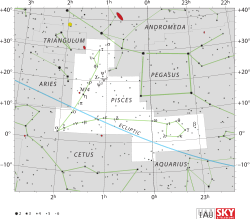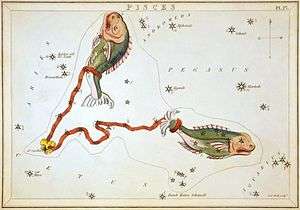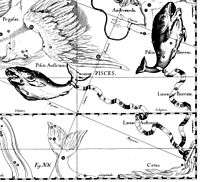Pisces (constellation)
Pisces is a constellation of the zodiac and is located in the Northern celestial hemisphere. Its name is the Latin plural for fish. It lies between Aquarius to the west and Aries to the east. The ecliptic and the celestial equator intersect within this constellation and in Virgo. Its symbol is ![]()
| Constellation | |
 | |
| Abbreviation | Psc |
|---|---|
| Genitive | Piscium |
| Pronunciation | /ˈpaɪsiːz/, genitives /ˈpɪʃiəm/ |
| Symbolism | the Fishes |
| Right ascension | 1h |
| Declination | +15° |
| Quadrant | NQ1 |
| Area | 889 sq. deg. (14th) |
| Main stars | 18 |
| Bayer/Flamsteed stars | 86 |
| Stars with planets | 13 |
| Stars brighter than 3.00m | 0 |
| Stars within 10.00 pc (32.62 ly) | 8 |
| Brightest star | η Psc (Alpherg) (3.62m) |
| Messier objects | 1 |
| Meteor showers | Piscids |
| Bordering constellations | |
| Visible at latitudes between +90° and −65°. Best visible at 21:00 (9 p.m.) during the month of November. | |
Features

The vernal equinox is currently located in Pisces, due south of ω Psc, and, due to precession, slowly drifting below the western fish towards Aquarius.
Stars
- Van Maanen's Star, at 12.35 magnitude, is located in this constellation, along with others, such as HD 222410, at 7.45 magnitude.
- Alrescha ("the cord"), otherwise Alpha Piscium (α Psc), 309.8 lightyears, class A2, apparent magnitude 3.62
- Fumalsamakah[1] ("mouth of the fish"), otherwise Beta Piscium (β Psc), 492 lightyears, class B6Ve, apparent magnitude 4.48
- Delta Piscium(δ Psc), 305 lightyears, class K5III, apparent magnitude 4.44
- Epsilon Piscium (ε Psc), 190 lightyears, class K0III, apparent magnitude 4.27
- Revati[1] ("rich"), otherwise Zeta Piscium (ζ Psc), 148 lightyears, class A7IV, apparent magnitude 5.21
- Alpherg ("pouring point of water")[1], otherwise Eta Piscium (η Psc), 349 lightyears, class G7 IIIa, apparent magnitude 3.62
- Torcular ("thread")[1], otherwise Omicron Piscium (ο Psc), 258 lightyears, class K0III, apparent magnitude 4.2
- Omega Piscium (ω Psc), 106 lightyears, class F4IV, apparent magnitude 4.03
- Gamma Piscium (γ Psc), 320 lightyears, apparent magnitude 12.078.
- Κομμένο πρόσωπο Piscium (έ Psc), 680 lightyears, apparent magnitude 16.9
Deep-sky objects
M74 is a loosely wound (type Sc) spiral galaxy in Pisces, found at a distance of 30 million light years (redshift 0.0022). It has many clusters of young stars and the associated nebulae, showing extensive regions of star formation. It was discovered by Pierre Méchain, a French astronomer, in 1780. A type II-P supernova was discovered in the outer regions of M74 by Robert Evans in June 2003; the star that underwent the supernova was later identified as a red supergiant with a mass of 8 solar masses.[2]
NGC 488 is an isolated face-on prototypical spiral galaxy.
NGC 520 is a pair of colliding galaxies located 90 million lightyears away.
CL 0024+1654 is a massive galaxy cluster that lenses the galaxy behind it, creating arc-shaped images of the background galaxy. The cluster is primarily made up of yellow elliptical and spiral galaxies, at a distance of 3.6 billion light-years from Earth (redshift 0.4), half as far away as the background galaxy, which is at a distance of 5.7 billion light-years (redshift 1.67).[2]
3C 31 is an active galaxy and radio source in Perseus located at a distance of 237 million light-years from Earth (redshift 0.0173). Its jets, caused by the supermassive black hole at its center, extend several million light-years in both directions, making them some of the largest objects in the universe.[2]
History and mythology

Pisces originates from some composition of the Babylonian constellations Šinunutu4 "the great swallow" in current western Pisces, and Anunitum the "Lady of the Heaven", at the place of the northern fish. In the first-millennium BC texts known as the Astronomical Diaries, part of the constellation was also called DU.NU.NU (Rikis-nu.mi, "the fish cord or ribbon").[3]
Greco-Roman period
Pisces is associated with the Greek legend that Aphrodite and her son Eros either shape-shifted into forms of fishes to escape, or were rescued by two fishes.
In the Greek version according to Hyginus, Aphrodite and Eros while visiting Syria fled from the monster Typhon by leaping into the Euphrates River and transforming into fishes (Poeticon astronomicon 2.30, citing Diognetus Erythraeus).[4] The Roman variant of the story has Venus and Cupid (counterparts for Aphrodite and Eros) carried away from this danger on the backs of two fishes (Ovid Fasti 2.457ff).[5][6] And in the version by the Persian astronomer al-Sufi, Venus and Cupid tied themselves together with a cord in order not to lose each other in the Euphrates.[7] The knot of the rope is marked by Alpha Piscium (α Psc), also called Al-Rischa ("the cord" in Arabic).[8]
There is also a somewhat different origin tale that Hyginus preserved in another work. According to this, an egg rolled into the Euphrates, and some fishes nudged this to shore, after which the doves sat on the egg until Aphrodite (thereafter called the Syrian Goddess) hatched out of it. The fishes were then rewarded by being placed in the skies as a constellation (Fabulae 197).[9][10] This story is also recorded by the Third Vatican Mythographer.[11]
Modern period

In 1690, the astronomer Johannes Hevelius in his Firmamentum Sobiescianum regarded the constellation Pisces as being composed of four subdivisions:[12]
- Piscis Boreus (the North Fish): σ – 68 – 65 – 67 – ψ1 – ψ2 – ψ3 – χ – φ – υ – 91 – τ – 82 – 78 Psc.
- Linum Boreum (the North Cord):[12] χ – ρ,94 – VX(97) – η – π – ο – α Psc.
- Linum Austrinum (the South Cord):[12] α – ξ – ν – μ – ζ – ε – δ – 41 – 35 – ω Psc.
- Piscis Austrinus (the South Fish):[12] ω – ι – θ – 7 – β – 5 – κ,9 – λ – TX(19) Psc.
Be aware that Piscis Austrinus more often refers to a separate constellation in its own right. Both (smaller) fish depicted in Pisces are said to be the offspring of the one greater fish in the constellation Piscis Austrinus.
In 1754, the astronomer John Hill proposed to treat part of Pisces as a separate constellation, called Testudo (the Turtle)[13] 24 – 27 – YY(30) – 33 – 29 Psc.,[14] centred a natural but faint asterism in which the star 20 Psc is intended to be the head of the turtle. While Admiral Smyth mentioned the proposal,[15] it was largely neglected by other astronomers, and it is now obsolete.
Western folklore
The Fishes are also associated with the German legend of Antenteh, who owned just a tub and a crude cabin when he met a magical fish. They offered him a wish, which he refused. However, his wife begged him to return to the fish and ask for a beautiful furnished home. This wish was granted, but her desires were not satisfied. She then asked to be a queen and have a palace, but when she asked to become a goddess, the fish became angry and took the palace and home, leaving the couple with the tub and cabin once again. The tub in the story is sometimes recognized as the Great Square of Pegasus.[16]
In non-Western astronomy
The stars of Pisces were incorporated into several constellations in Chinese astronomy. Wai-ping ("Outer Enclosure") was a fence that kept a pig farmer from falling into the marshes and kept the pigs where they belonged. It was represented by Alpha, Delta, Epsilon, Zeta, Mu, Nu, and Xi Piscium. The marshes were represented by the four stars designated Phi Ceti. The northern fish of Pisces was a part of the House of the Sandal, Koui-siou.[8]
Astrology
Pisces is a dim constellation located next to Aquarius, and Aries. While the astrological sign Pisces per definition runs from ecliptical longitude 330° to 0, this position is now mostly covered by the constellation of Aquarius, due to the precession from when the constellation and the sign roughly coincided.
See also
References
- "Naming Stars". IAU.org. Retrieved 8 August 2018.
- Wilkins, Jamie; Dunn, Robert (2006). 300 Astronomical Objects: A Visual Reference to the Universe (1st ed.). Buffalo, New York: Firefly Books. ISBN 978-1-55407-175-3.
- Origins of the ancient constellations: I. The Mesopotamian traditions by J. H. Rogers 1998, page 19 page 19 (table 3, rows 2-3) and page 27
- Hard (2015), pp. 84–85.
- Hard (2015), pp. 85–86.
- Publius Ovidius Naso (1995). Ovid's Fasti: Roman Holidays. Translated by Betty Rose Nagle. Indiana University Press. pp. 69–70, 182. ISBN 9-780-25320-933-7.
- Staal (1988), p. 46.
- Staal (1988), pp. 45–47.
- Rigoglioso, Marguerite (2009). The Cult of Divine Birth in Ancient Greece. Springer. p. 248. ISBN 978-0-230-62091-9.
- Ridpath (1988), p. 108.
- Van Berg, Paul-Louis (1972). Corpus Cultus Deae Syriae - Ccds: Les Sources Litteraires - Repertoire Des Sources Grecques Et Latines - Sauf Le De Dea Syria - (in French). Brill Archive. pp. 37–38. ISBN 9-789-00403-503-4.CS1 maint: ref=harv (link)
- Hevelius, J., (1690) Firmamentum Sobiescianum, Leipzig, Fig.NN
- Allen, R. H. (1963). Star Names: Their Lore and Meaning (Reprint ed.). New York, NY: Dover Publications Inc. p. 163 342. ISBN 978-0-486-21079-7.
- Ciofi, Claudio; Torre, Pietro, Costellazioni Estinte (nate dal 1700 al 1800): Sezione di Ricerca per la Cultura Astronomica
- Smyth, W. H., (1884) The Bedford Catalogue, p. 23
- Staal (1988), pp. 45–46.
Sources
- Ridpath, Ridpath (1988). Star Tales. James Clarke & Co. ISBN 978-0-718-82695-6.CS1 maint: ref=harv (link)
- Ridpath, Ridpath; Tirion, Wil (2007). Stars and Planets Guide (4th ed.). Princeton University Press. ISBN 978-0-691-13556-4.CS1 maint: ref=harv (link)
- Eratosthenes; Hyginus; Aratus (2015). Hard, Robin (ed.). Constellation Myths: with Aratus's Phaenomena. OUP Oxford. pp. 83–85. ISBN 978-0-191-02652-2.
- Richard Hinckley Allen, Star Names, Their Lore and Legend, New York, Dover: various dates.
- Staal, Julius D. W. (1988). The New Patterns in the Sky: Myths and Legends of the Stars. The McDonald and Woodward Publishing Company. ISBN 978-0-939923-04-5.CS1 maint: ref=harv (link)
- Thomas Wm. Hamilton, Useful Star Names, Strategic Books, 2008.
External links
| Wikimedia Commons has media related to: |